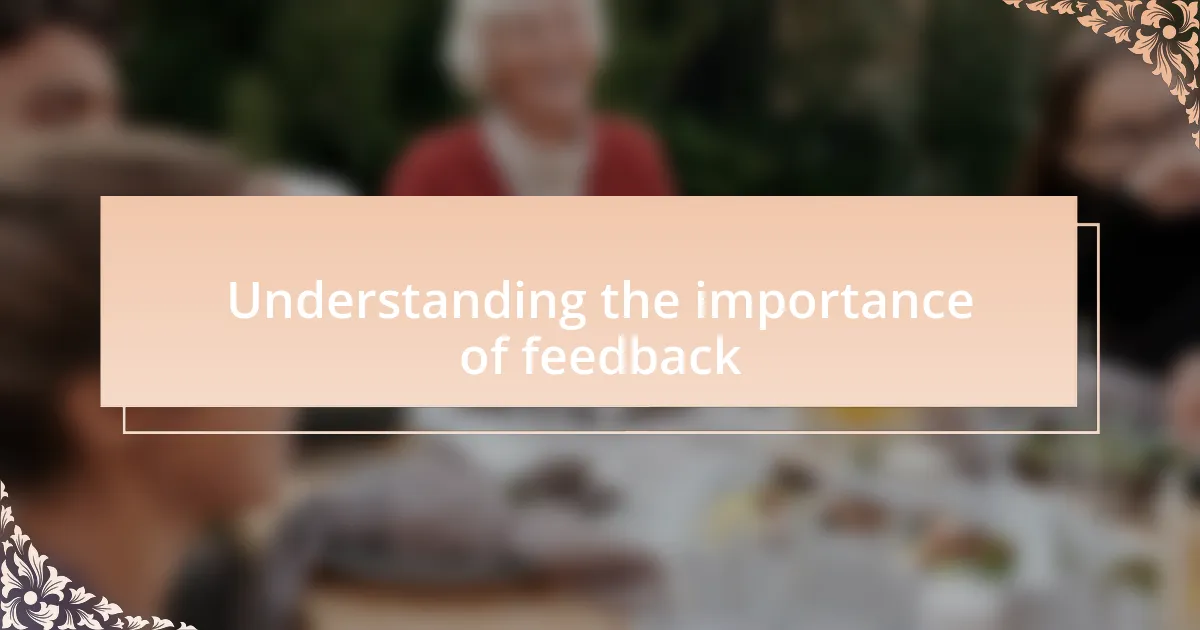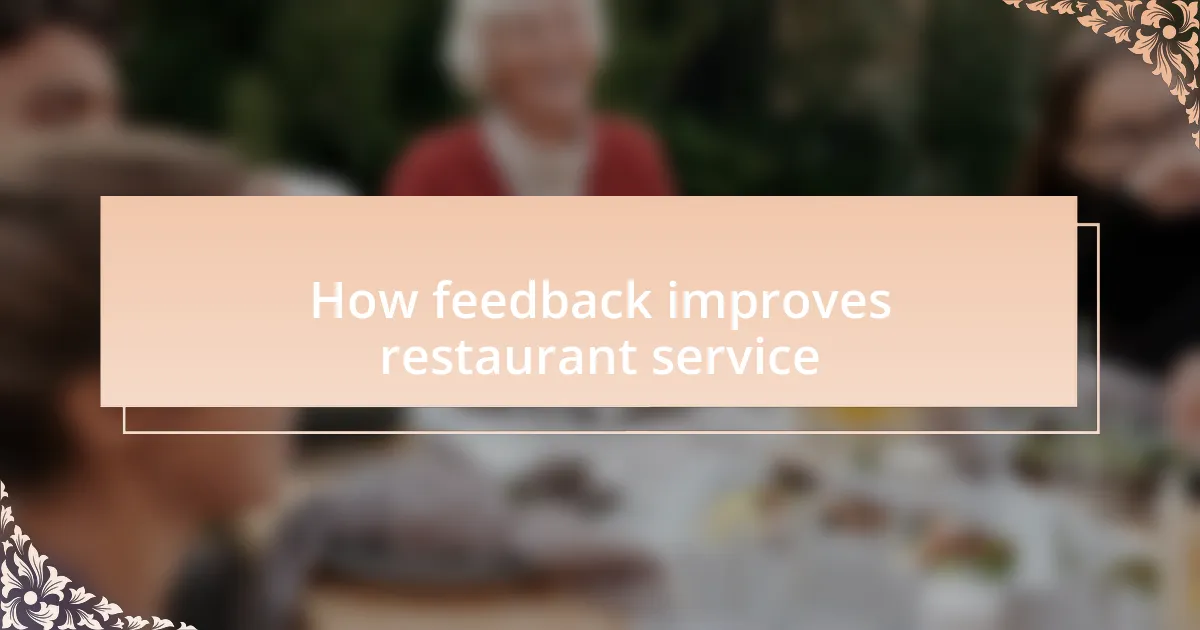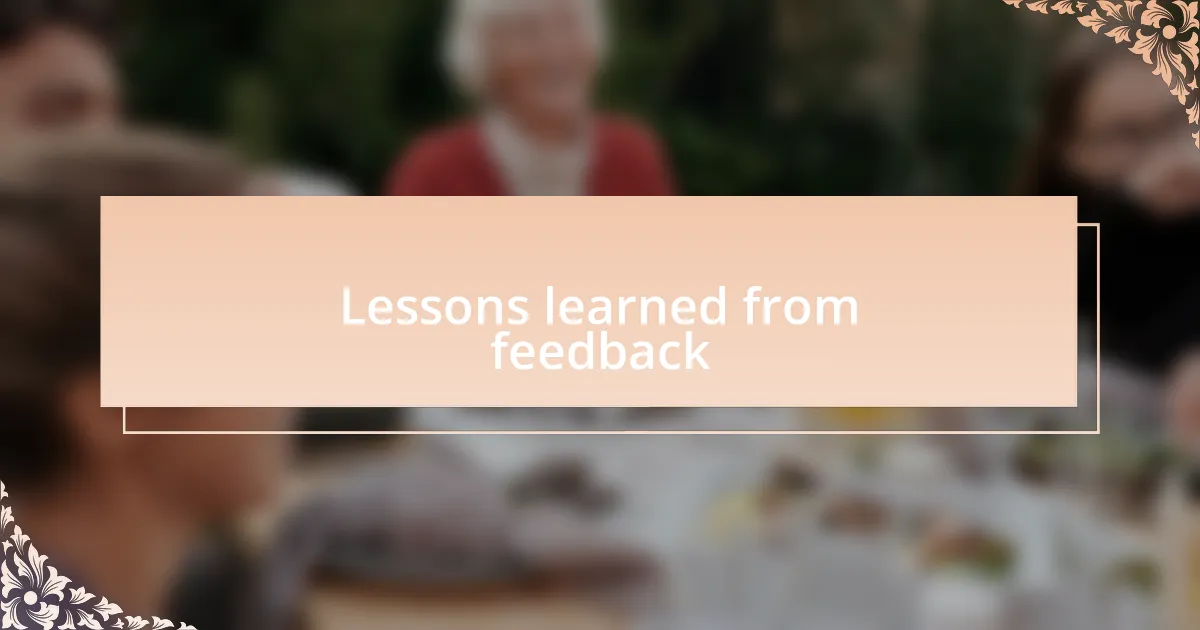Key takeaways:
- Feedback is a valuable tool for continuous improvement and can transform both dishes and dining experiences.
- Engaging with customers about their feedback fosters loyalty and encourages innovative menu changes.
- Analyzing patterns in customer comments helps refine services and enrich the overall dining experience.
- Negative feedback can serve as a catalyst for positive changes in operations and menu offerings.

Understanding the importance of feedback
Feedback is a powerful tool that often goes overlooked in the fast-paced world of dining. I remember a time when a customer expressed dissatisfaction with our brunch special, claiming it lacked flavor. Initially, I felt defensive, but that feedback prompted us to reevaluate our ingredients and seasoning. The result? A revamped dish that has since become a guest favorite.
Recognizing the importance of feedback means understanding its emotional weight. It’s not just about what customers say; it’s about how they feel when they dine with us. For instance, when a patron shared how our brunch made their family gathering special, it underscored the impact that our service and food could have on personal experiences. Can you imagine how that one piece of feedback transformed our perception of our roles? It made us more than just a restaurant; we became a part of their cherished memories.
When I consider the evolution of my own understanding of feedback, it feels like a journey. I used to view criticism as a setback, but now I see it as an opportunity for growth. I often ask myself, “What can I learn from this?” Embracing feedback has shown me that it’s a dialogue, not a monologue—each comment shapes our restaurant’s identity and ensures we’re meeting our guests’ expectations.

How feedback improves restaurant service
Receiving feedback is like having a window into our customers’ experiences, which is invaluable for enhancing our restaurant service. I vividly recall a guest who pointed out that our coffee was served lukewarm. At first, I brushed it off, but then I thought, “What if this affects their enjoyment of brunch?” Since then, we’ve made it a priority to serve fresh coffee at the right temperature, and our repeat customers have noticed the difference.
Feedback doesn’t just help with specific issues; it builds a stronger connection with our diners. I’ve found that engaging with customers about their thoughts helps us foster loyalty. Last month, a couple shared their ideas about gluten-free options. Instead of writing it off, we took their suggestions seriously. The result? A new menu item that not only satisfied their needs but also attracted more health-conscious diners. Isn’t that a win-win?
Ultimately, feedback is a reflection of our diner’s hopes and expectations. When I hear stories from our guests, like a birthday celebration enhanced by our attentive service, it hits home. It reminds me that every detail matters. After all, isn’t it our goal to create not just meals but memorable experiences that keep guests coming back?

Types of feedback we receive
One of the most common types of feedback we receive revolves around service quality. For instance, I’ll never forget the time a family mentioned how our servers went above and beyond to accommodate their children’s dietary preferences. That’s the kind of insight that excites me—when our staff’s efforts resonate with our guests. It’s affirming to know that our focus on hospitality can turn a simple meal into a delightful family experience.
Another significant category is the food itself, including taste and presentation. Recently, a guest posted online about how much they loved our avocado toast but felt it could use a bit more seasoning. Rather than be offended, I took their comment to heart. I experimented with some new spices, and now that dish has evolved into one of our most popular menu items. Isn’t it amazing how a simple suggestion can lead to something extraordinary?
Lastly, we hear a lot about the ambiance of our restaurant. I once had a couple share that they loved the cozy vibe but suggested adding more greenery to brighten the space. I found this feedback both constructive and inspiring. After introducing some plants, several return customers mentioned how the atmosphere felt even more inviting. Isn’t it fascinating how little changes can elevate the entire dining experience?

Gathering feedback from customers
Gathering feedback from customers is essential for continuous improvement. I vividly remember a time when a guest shared their thoughts about our brunch menu. They praised our pancakes but felt they were a bit too dense. This honest feedback encouraged us to revisit the recipe, and we ended up creating a fluffier version that customers now rave about. Doesn’t it make you wonder how one piece of feedback can transform a classic dish?
I’ve also learned that the medium through which we gather feedback can make a difference. One day, I decided to set up a small feedback box on our counter, inviting guests to jot down their thoughts anonymously. It was eye-opening to see the candid responses—it revealed areas we hadn’t even considered, like the speed of service during peak hours. Have you ever been surprised by what people really think when given a chance to share openly?
Additionally, engaging with customers through social media has become a powerful avenue for feedback. I recall a lively conversation on Instagram where a guest suggested a seasonal brunch special that celebrated local produce. Responding directly to their idea made them feel valued and invested in our menu. It’s incredible how fostering a community around feedback not only enhances the dining experience but also connects people to our brand. Wouldn’t you agree that collaboration with customers can pave the way for innovative culinary experiences?

Analyzing customer feedback effectively
Analyzing customer feedback effectively requires a keen understanding of the nuances in what patrons express. I once analyzed a series of comments we received online about our brunch cocktails. While many loved their flavors, several mentioned that they found them too sweet. This prompted me to not just adjust the sugar levels but also to consider the balance of flavors overall. Isn’t it fascinating how a single aspect can impact a guest’s enjoyment?
When I dive into feedback, I pay special attention to patterns that emerge over time. For instance, a recurring complaint about our coffee led me to hold a tasting session with my team. I quickly realized that the brewing method wasn’t serving our quality expectations. The customer’s voice was powerful enough to refresh our entire coffee process. Can you imagine the potential impact of closely monitoring such feedback?
Moreover, it’s essential to contextualize feedback within the broader dining experience. I recalled during a particularly busy brunch, a customer mentioned they loved our ambiance but felt we were too loud. This pushed me to reflect on how ambiance intertwines with food quality. Shouldn’t we create an environment that supports our culinary vision? Now, I think deeply about how the overall experience can elevate each dish we serve, influenced heavily by what our diners share with us.

Lessons learned from feedback
Listening to feedback has taught me the importance of adaptability in a bustling brunch environment. I remember when we received comments about our eggs benedict; while some guests adored it, others felt the hollandaise was too tangy. This pushed me to experiment with a milder recipe. The joy of seeing a diversified menu, reflecting our customers’ tastes, felt rewarding. Isn’t it incredible how our dishes can evolve based on the voices of our loyal patrons?
I find that middle-of-the-road dishes tend to get overlooked, which has been a valuable lesson from our feedback. One Sunday, a regular guest excitedly told me how our avocado toast was a staple for her, but she mentioned our side salads seemed bland in comparison. Reflecting on this, I arranged for a seasonal salad revamp, incorporating local produce. It was gratifying to see guests returning for that fresh spin. Doesn’t it make you wonder how often hidden gems in our menu can shine brighter with just a little input?
Furthermore, handling negative feedback can be a powerful learning opportunity. There was a time when a guest left a review about the wait times during peak hours. At first, it stung, but it sparked an idea for our brunch flow. By analyzing our service pace and reallocating staff, I managed to enhance efficiency. This lesson reminded me that constructive criticism is just a stepping stone for growth. How many times have our missteps led to greater successes in the end?